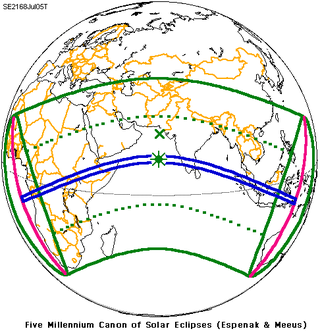Solar eclipse of July 5, 2168
| Solar eclipse of July 5, 2168 | |
|---|---|
| Type of eclipse | |
| Nature | Total |
| Gamma | −0.166 |
| Magnitude | 1.0807 |
| Maximum eclipse | |
| Duration | 446 s (7 min 26 s) |
| Coordinates | 13°12′N 66°24′E / 13.2°N 66.4°E |
| Max. width of band | 264 km (164 mi) |
| Times (UTC) | |
| Greatest eclipse | 7:45:23 |
| References | |
| Saros | 139 (38 of 71) |
| Catalog # (SE5000) | 9889 |
A total solar eclipse will occur on July 5, 2168. A solar eclipse occurs when the Moon passes between Earth and the Sun, thereby totally or partly obscuring the image of the Sun for a viewer on Earth. A total solar eclipse occurs when the Moon's apparent diameter is larger than the Sun's, blocking all direct sunlight, turning day into darkness. Totality occurs in a narrow path across Earth's surface, with the partial solar eclipse visible over a surrounding region thousands of kilometres wide. Lasting a maximum of 7 minutes, 26 seconds, it will be the longest eclipse since the 11th century, which lasted 7 minutes and 20 seconds, as well with the next two occurrences.
Related eclipses
Saros 139
This eclipse is a part of Saros series 139, repeating every 18 years, 11 days, and containing 71 events. The series started with a partial solar eclipse on May 17, 1501. It contains hybrid eclipses from August 11, 1627 through December 9, 1825 and total eclipses from December 21, 1843 through March 26, 2601. There are no annular eclipses in this set. The series ends at member 71 as a partial eclipse on July 3, 2763. Its eclipses are tabulated in three columns; every third eclipse in the same column is one exeligmos apart, so they all cast shadows over approximately the same parts of the Earth.
The longest duration of totality will be produced by member 61 at 7 minutes, 29.22 seconds on July 16, 2186. This date is the longest solar eclipse computed between 4000 BC and AD 6000.[1] All eclipses in this series occur at the Moon’s ascending node of orbit.[2]
| Series members 18–39 occur between 1801 and 2200: | ||
|---|---|---|
| 18 | 19 | 20 |
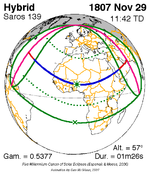 November 29, 1807 |
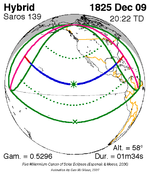 December 9, 1825 |
 December 21, 1843 |
| 21 | 22 | 23 |
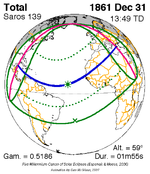 December 31, 1861 |
 January 11, 1880 |
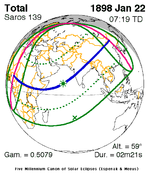 January 22, 1898 |
| 24 | 25 | 26 |
 February 3, 1916 |
 February 14, 1934 |
 February 25, 1952 |
| 27 | 28 | 29 |
 March 7, 1970 |
 March 18, 1988 |
 March 29, 2006 |
| 30 | 31 | 32 |
 April 8, 2024 |
 April 20, 2042 |
 April 30, 2060 |
| 33 | 34 | 35 |
 May 11, 2078 |
 May 22, 2096 |
 June 3, 2114 |
| 36 | 37 | 38 |
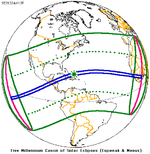 June 13, 2132 |
 June 25, 2150 |
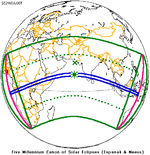 July 5, 2168 |
| 39 | ||
 July 16, 2186 | ||
References
- ^ Ten Millennium Catalog of Long Solar Eclipses, −3999 to +6000 (4000 BCE to 6000 CE) Fred Espenak.
- ^ "NASA - Catalog of Solar Eclipses of Saros 139". eclipse.gsfc.nasa.gov.

